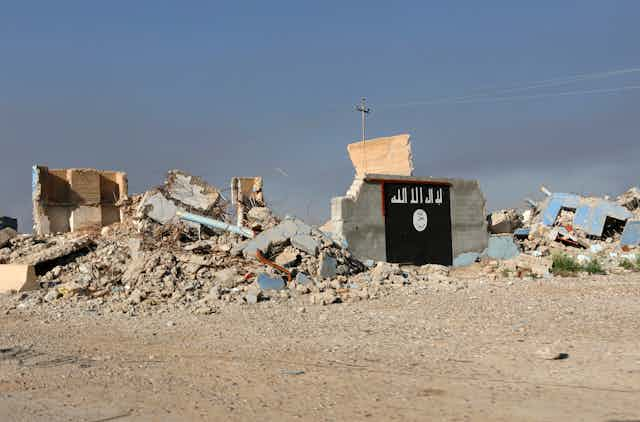The terror attacks in Paris that killed well over 120 people and injured many more mark a particularly deadly turn in the West’s struggle to crush Islamic State (IS) – but they fit a pattern of behaviour the group has been pursuing for months.
IS and its affiliates have also claimed responsibility for gunning down 38 tourists on a Tunisian beach in June, bringing down a Russian airliner and killing its 224 occupants over Egypt in October and bombing a Shia area of southern Beirut, killing 44 people, on November 12. It’s also suspected of being involved in a suicide attack in Ankara that killed 102.
This is a big change of tack. Initially focused on building a functioning caliphate/state and eliminating opponents in Syria and Iraq, the group has shifted strategy and is now staging attacks on opponents outside the region. IS is often labelled a terrorist group, but dealing with it is much more complicated than eliminating a typical terrorist organisation.
What makes IS so different?
IS is not just a terrorist group. Like al-Qaeda, for instance, it consists of cells and affiliates, and inspires lone wolf acts of violence, but it is also capable of both providing some administrative services to the people under its captivity, engaging in organised crime and pursuing a full-blown insurgency. IS is a hybrid organisation, which makes it all the more challenging to deal with.
Terrorist groups of the past were mostly hierarchical, tightly organised, highly secretive with very selective recruitment. But that very clear leadership structure meant that “decapitation” strategies of killing off the leadership usually resulted in the demise of the organisation, and made their survival contingent on the survival of their leaders. Whereas conventional wisdom (based in large part on studies of groups in the US) once held that most terrorist groups last less than a year, more recent studies indicate that they now last 14 years on average.
Terrorist groups can endure for longer by flattening the hierarchies of their organisations. This means that exterminating one cell does little to affect the strength of the organisation. Sure enough, though US-led coalition airstrikes apparently continue to kill off IS’s leaders, their impact is lessened by the proliferation of new cells ready to defend the group’s values.

IS and its ilk are skilled recruiters, using the internet and informal networks. They can therefore rely on a steady flow of terrorists ready and willing to fight. Instead of going through a tightly controlled and highly competitive recruitment process, IS has a well-funded web and social media propaganda campaign disseminating videos of brutal violence and destruction to appeal to potential followers. It also distributes an English language magazine, Dabiq.
Taking advantage of improvements in technology and transportation, the Islamic State (like al-Qaeda) contrasts with past terrorist groups that remained more domestic and nationalist. Today’s terrorist groups are transnational – European and North African recruits are incorporated into cells based in Europe and beyond. Unable to migrate to fight in Syria, they are being used to stage attacks in the countries in which they are based.
Driven by ideology, the conventional terrorist organisations of yesteryear mostly received their support from state sponsors. But today, most terrorist groups engage in organised criminal activities to keep their organisations thriving. IS has flexible and lucrative sources of funding. Most of this comes from illicit proceeds from occupying territory such as controlling banks, oil and gas reservoirs, extortion and theft of economic assets. IS also earns funds by kidnapping for ransom and donations from non-profits and foreign fighters.
By not relying on foreign funding, the group is not vulnerable to a sudden loss of support. Additionally, the group’s motives also mutate. Lucrative criminal opportunities motivate the group. They also provide a constant flow of funding for further attacks.
Holding territory
Occupying territory is also a something that distinguishes terrorist-hybrid organisations from terrorist groups of the past. Typically it is insurgencies that hold territories by force, whereas terrorist groups have been too weak to hold territory and must rely on a safe haven provided either passively or actively by a state sponsor.
IS holds territory roughly the size of Belgium, which it uses as a base to train its militias and conduct and plan its operations. More than 60% of its funds goes towards paying its military. By holding territory and providing services to the people who live there, it can operate more freely than groups which lack a large base for its headquarters.
Though the organisation is transnational and cellular, it also has a robust organisation capable of planning carefully orchestrated attacks and offering the financial and logistical support necessary to make its attacks highly deadly. The Paris attacks were too sophisticated and effective to be the work of leaderless resistance or lone-wolf terrorism. As the French prime minister, Manuel Valls, has now officially stated, they were very probably planned from the top in Syria, rather than by an autonomous cell based in France.
But in spite of its unusually clear hierarchical leadership structure, simply killing IS’s top leaders and destroying its resources and supply lines (as post-Paris attacks on Raqqa seem to be aiming for) will still be ineffective. The only way to deal effectively with the group will require a long-term plan of eliminating the deep sources of frustration in the region, such as government corruption, mismanagement and state violence.

